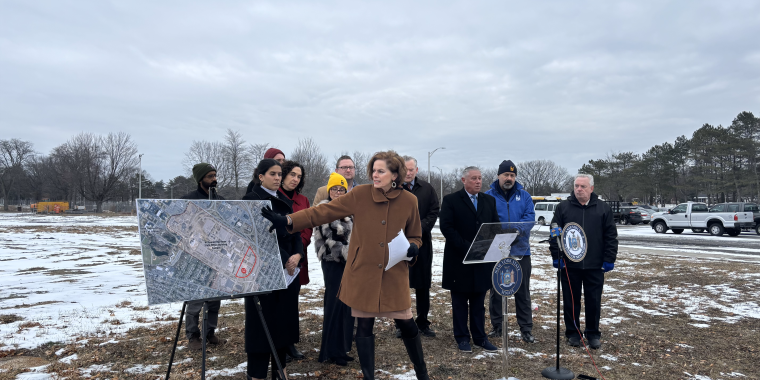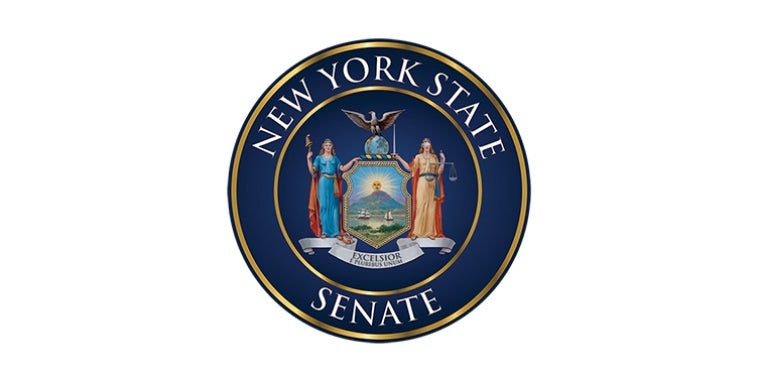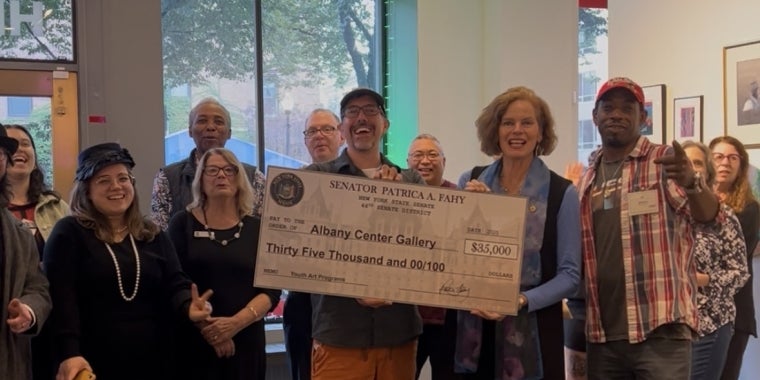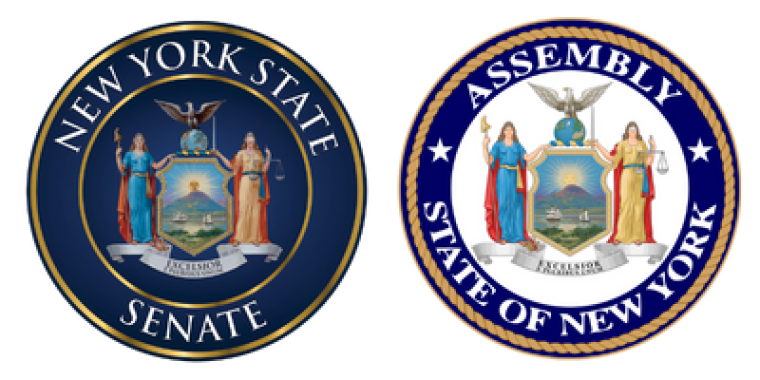
Capital Region Lawmakers Introduce Bill to Require Housing, Retail Space on Harriman Campus as Part of Wadsworth Labs Project
January 13, 2025
-
ISSUE:
- Albany

ALBANY, N.Y. – Senator Patricia Fahy (D—Albany) was joined today by Assemblymembers Gabriella Romero (D—Albany) and John T. McDonald, III (D—Cohoes), Albany County Legislator Frank Commisso, Albany Common Councilmembers Tom Hoey and Ginnie Farrell, Greater Capital Region Building and Construction Trades President Michael Lyons, and Capital Streets Board Member Ben MacKrell to introduce legislation (S.1613) requiring the Office of General Services (OGS) to designate 7 acres for mixed-use commercial, retail, or residential development of the 27-acre Harriman State Office Campus set aside for the $1.7 billion Wadsworth Public Health Laboratory project.
This legislation intends to ensure a 21st Century-economic development approach that will foster the growth of the regional economy and better integrate the surrounding community on the Harriman Campus, and is supported by Governor Hochul’s Executive Order mandating state agencies to review lands in their ownership and control to determine whether the sites could be used either for housing development or to support nearby housing developments.
“New York’s $1.7 billion Wadsworth Labs project is the largest state investment in the Harriman Campus since its construction and requiring that acres are set aside for housing and retail space ensures we’re harnessing the full potential of the project in the public’s interest,” said New York State Senator Patricia Fahy. “Redesignating a portion of the 27-acre Wadsworth Project to be used for mixed-use commercial, retail, and residential space will ensure that we’re maximizing the economic development potential of this project on what could now be considered Albany’s uptown ‘Parking Lot District’. Accordingly, this will not impact the footprint of the Wadsworth Lab design nor cause any delay and does not preclude our eagerness to see shovels in the ground as soon as this spring. Ensuring that we’re limiting the number of surface-level parking spaces, reserving dedicated space for new housing stock and small businesses, and reconnecting the Campus with the surrounding neighborhoods must be critical components of this project moving forward. I look forward to working with OGS, ESD, and more to ensure that we’re harnessing the full multiplier effects and potential as part of this transformative project.”
New York’s decision to relocate the Wadsworth Public Health Labs to the Harriman Office Campus was a result of years-long advocacy to ensure the laboratories remained in the City of Albany and the broader Capital Region. Existing plans for the consolidation of the Wadsworth Health Labs include a dramatic expansion of parking spaces and no opportunities for mixed-use commercial, retail, and residential space, or Transit-Oriented Development (TOD). As the state seeks to redevelop the Wadsworth Public Health Labs, it should prioritize economic development on the Harriman Campus that can incubate businesses, provide new housing options to help address the local and statewide housing crisis, and collocate workers directly adjacent to the Harriman Campus.
Harnessing the full economic multiplier effects of the Wadsworth Laboratory project and the state’s largest investment in the Capital Region since the 1960s will reconnect the surrounding community and neighborhoods and allow them to realize the full potential of a project of this size and scale. Co-locating mixed-use commercial and residential space will assist in undoing the car-centric and transportation planning mistakes of the ‘60s, which culminated in the inclusion of Harriman’s ‘ring roads’ that direct traffic flow out of the City of Albany, rather than into it. A 2007 study completed by the Capital Region Transportation Council (CRTC), the Capital Region’s Metropolitan Planning Organization (MPO), called for mixed-use and residential development to complement a redesign of Harriman’s existing transportation grid, unlocking major economic development opportunities.
Sixty-three percent of the City of Albany’s properties, including the Harriman State Office Campus, are considered tax-exempt. Encouraging spinoff development on these acres can help alleviate Albany’s unique tax burden as the state’s capital city. Finally, encouraging greater walkability and multi-modal transportation will reduce the need for additional parking spaces, stimulate the local economy, and incentivize private sector investment.
"The redevelopment of the Harriman Campus offers a unique opportunity to transform the heart of Albany into a vibrant, mixed-use community,” said Assemblymember Gabriella Romero. “By reserving seven acres for commercial, retail, and residential development, we can ensure that the $1.7 billion Wadsworth Labs project not only strengthens public health infrastructure but also spurs local economic growth and addresses the housing crisis. This is a chance to create a more walkable, connected neighborhood that benefits residents, businesses, and the broader Capital Region. I'm proud to push this initiative with Senator Patricia Fahy and Assemblymember John T. McDonald, III, which reflects our commitment to building a sustainable future for Albany and its surrounding communities."
"As we embark on the new Wadsworth Public Health Laboratory this year it is time to also consider, without interfering with the construction project, the potential to support this effort by exploring future residential and commercial opportunities,” said Assemblymember John T. McDonald, III. “This effort, which will expand the tax base of Albany by developing land that has been off the tax rolls for generations, should have a heightened focus on collaboration and integration with the neighborhoods surrounding Harriman. Wadsworth Laboratory will be the most advanced research public health lab in the country and will serve as a beacon to attract world-class talent to call Albany and the Capital Region home. That is why we must take this next critical step in the process."
"The City of Albany carries the burden of hosting many acres of tax-exempt parking lots at the Harriman Campus. For those who live in Albany, the Harriman Campus is a black hole that separates neighborhoods -- a sprawling area designed in the 1960s for those who live in the suburbs to commute in and out without ever spending their money or paying taxes to the city in which they work,” said Jackie Gonzales, Project Director of Capital Streets. “If the State is serious about helping to reconnect historically disadvantaged communities, we should be reconnecting communities, not dividing them. Retaining a campus with no transit-oriented or walkable development means the Harriman Campus remains a black hole to the over 20% of Albany households who do not have access to a car. Developing mixed-use residential, commercial, and retail space on the Harriman campus will also help the State attract employees who want to live, work, and play in Albany. Unlike in the 1960s, talented people are not excited about a life in which they drive to an office campus surrounded by parking lots and then drive back to their home in the suburbs. If the State wants to attract talented people to work at this world-class lab, we should build the walkable, vibrant communities that cannot exist in a sea of parking lots and single-use development. Senator Fahy's legislation would return underutilized state land to productive development in Albany, connecting communities rather than continuing to divide them."
###
related legislation
Share this Article or Press Release
Newsroom
Go to Newsroom


